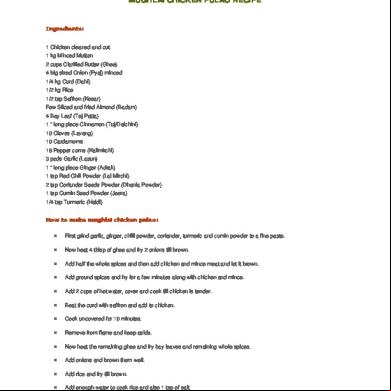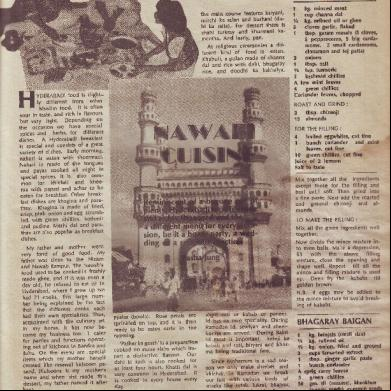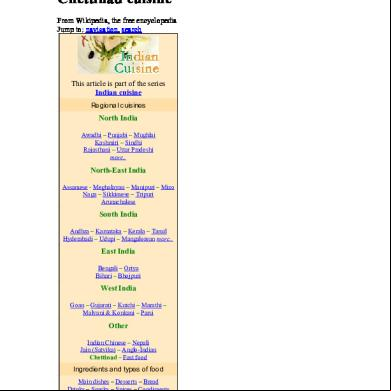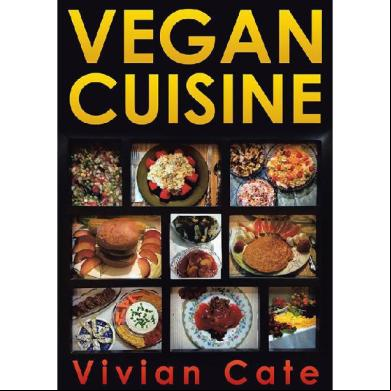Mughlai Cuisine 2k6x44
This document was ed by and they confirmed that they have the permission to share it. If you are author or own the copyright of this book, please report to us by using this report form. Report 3b7i
Overview 3e4r5l
& View Mughlai Cuisine as PDF for free.
More details w3441
- Words: 691
- Pages: 2
Mughlai cuisine is a style of cooking developed in the Indian subcontinent by the imperial kitchens of the Mughal Empire. It represents the cooking styles used in North India (especially Uttar Pradesh and Delhi), Pakistan, Bangladesh and the Indian city of Hyderabad. The cuisine is strongly influenced by the Persian cuisine of Iran, and has in turn strongly influenced the regional cuisines of Kashmir and the Punjab region. The tastes of Mughlai cuisine vary from extremely mild to spicy, and is often associated with a [1] distinctive aroma and the taste of ground and whole spices. A Mughlai course is an elaborate buffet of main course dishes with a variety of accompaniments. Dishes The names of the dishes are quite often Persian, the official language of the Mughal court. Dishes include various kebabs, kofta(meatballs), nihari, pulao (a.k.a. pilaf in Central Asia), and biryani. Paneer is used for preparing vegetarian dishes to suit vegetarian dietary requirements. Other dishes include:
Mughlai Chicken[1] Mughai paratha[2] Biryani Badshahi Keema Matar Meat Durbari Mughlai Chicken Pulao
Influences on Indian foods in the past have been many; notable amongst them are the Mughlai, Parsi, Jewish, Arabic, Turkish, Chinese, Portuguese, English and the French. Mughlai has probably had the most significant contribution in making the food globally popular. Due to its sheer brutal force, it has had a lasting impact on our foods. It is characterized by its opulence and extreme hospitality traditions. Largely ed by the state and its fiscal strength, Mughlai foods have been an important cultural bastion of the Rulers who were at the helm for a few hundred years. In its early stages its practice was restricted to the palaces and state banquets. The noblemen perhaps vied to employ the best of the cooks for a taste of the conjured delicacies. This art of conjuring has taken a new name in contemporary times called “Creativity” with a French flavor. Its beauty lies in its adaptation to local foods and traditions, like using spices without making it chili hot. What recipes constitute a Mughlai food is something hard to deduce. Some Awadhi foods with its Persian sounding names could be a part of Mughlai cuisine. Also some Delhi foods may owe its origins to a fall out of the entourage. In its composition, it seems to be largely an evolved cuisine, including its name, which is associated with the ruling dynasty. Mughals however originate from Mongolian ancestry. The evolution was necessitated by the assimilation of local food habits. In its contemporary form, it has been plagiarized to the extent of being insipid and boring. Anything with a hint of richness in the foods with a mild flavor is ed around as Mughlai. Korma and the Kalia are two base recipes that come to mind speaking of Mughlai foods. Though largely misunderstood, Korma has survived and has been very popular throughout the country in different forms. In its purest form it is a meatbased dish cooked with pure ghee, until all the gravy dries up and the ghee is separated. Kalia is water or milk based gravy product. Not very common, some instances of it can be found in Bengali and Kashmiri cuisines. Do Peeaza spelt differently is another misconstrued term. It originally denotes a meat based dish cooked with a vegetable, though in modern times it is globally accepted to be something that is cooked with two onions or twice the amount of onions.
Kebabs undoubtedly come from Turkish foods. It is probably the single most popular food item in the world having served over a few billions spread over a few centuries without the golden arch of course. Although considered a delicacy in Indian foods, it is a staple in Arabic, Turkish, North West Frontier of the subcontinent and North African foods. Basically a grilled meat, either done on an open grill or the tandoor, some may even be cooked on the tava or a stone slab as in Pathar kebabs. A few deep fried kebabs have also been doing the rounds. The basic principle is to sear the marinated meat retaining its juices, and cook till tender.
Mughlai Chicken[1] Mughai paratha[2] Biryani Badshahi Keema Matar Meat Durbari Mughlai Chicken Pulao
Influences on Indian foods in the past have been many; notable amongst them are the Mughlai, Parsi, Jewish, Arabic, Turkish, Chinese, Portuguese, English and the French. Mughlai has probably had the most significant contribution in making the food globally popular. Due to its sheer brutal force, it has had a lasting impact on our foods. It is characterized by its opulence and extreme hospitality traditions. Largely ed by the state and its fiscal strength, Mughlai foods have been an important cultural bastion of the Rulers who were at the helm for a few hundred years. In its early stages its practice was restricted to the palaces and state banquets. The noblemen perhaps vied to employ the best of the cooks for a taste of the conjured delicacies. This art of conjuring has taken a new name in contemporary times called “Creativity” with a French flavor. Its beauty lies in its adaptation to local foods and traditions, like using spices without making it chili hot. What recipes constitute a Mughlai food is something hard to deduce. Some Awadhi foods with its Persian sounding names could be a part of Mughlai cuisine. Also some Delhi foods may owe its origins to a fall out of the entourage. In its composition, it seems to be largely an evolved cuisine, including its name, which is associated with the ruling dynasty. Mughals however originate from Mongolian ancestry. The evolution was necessitated by the assimilation of local food habits. In its contemporary form, it has been plagiarized to the extent of being insipid and boring. Anything with a hint of richness in the foods with a mild flavor is ed around as Mughlai. Korma and the Kalia are two base recipes that come to mind speaking of Mughlai foods. Though largely misunderstood, Korma has survived and has been very popular throughout the country in different forms. In its purest form it is a meatbased dish cooked with pure ghee, until all the gravy dries up and the ghee is separated. Kalia is water or milk based gravy product. Not very common, some instances of it can be found in Bengali and Kashmiri cuisines. Do Peeaza spelt differently is another misconstrued term. It originally denotes a meat based dish cooked with a vegetable, though in modern times it is globally accepted to be something that is cooked with two onions or twice the amount of onions.
Kebabs undoubtedly come from Turkish foods. It is probably the single most popular food item in the world having served over a few billions spread over a few centuries without the golden arch of course. Although considered a delicacy in Indian foods, it is a staple in Arabic, Turkish, North West Frontier of the subcontinent and North African foods. Basically a grilled meat, either done on an open grill or the tandoor, some may even be cooked on the tava or a stone slab as in Pathar kebabs. A few deep fried kebabs have also been doing the rounds. The basic principle is to sear the marinated meat retaining its juices, and cook till tender.





